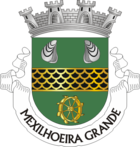Mexilhoeira Grande
| Mexilhoeira Grande | ||||||
|---|---|---|---|---|---|---|
|
||||||
| Basic data | ||||||
| Region : | Algarve | |||||
| Sub-region : | Algarve | |||||
| District : | Faro | |||||
| Concelho : | Portimão | |||||
| Coordinates : | 37 ° 10 ′ N , 8 ° 37 ′ W | |||||
| Residents: | 4029 (as of June 30, 2011) | |||||
| Surface: | 91.15 km² (as of January 1, 2010) | |||||
| Population density : | 44 inhabitants per km² | |||||
| Postal code : | 8500-132 | |||||
| politics | ||||||
| Mayor : | José Vitorino ( PS ) | |||||
| Address of the municipal administration: | Junta de Freguesia de Mexilhoeira Grande Bairro Figueiral Velho 8500-132 Mexilhoeira Grande |
|||||
| Website: | www.freguesiamexgrande.pt | |||||
Mexilhoeira Grande is a small town and municipality in the Algarve in southern Portugal .
The place Mexilhoeira Grande consists primarily of white houses and narrow streets and is located in the rural area north of Portimão. Most of the residents earn their living with traditional handicrafts and agriculture.
The local river Ria de Alvor is a Natura 2000 protected area.
The motor racing circuit Autódromo Internacional do Algarve is located in the municipality.
history
Finds prove a prehistoric settlement, u. a. the Copper Age settlement in Alcalar.
A large number of finds and excavations date back to Roman times, in particular the villa of Quinta da Abicada .
The place was probably abandoned in the 6th and 7th centuries. Arabs settled here from the 8th century , when the Algarve also became part of al-Andalus from 711 .
The current village of Mexilhoeira Grande was mentioned from the 14th century and has been an independent municipality since the 16th century.
King D. Carlos visited the village on October 12, 1897 when he got off at the Linha do Algarve train station there .
On November 1, 1999 Mexilhoeira Grande was elevated to a small town ( Vila ).
Attractions
In the vicinity of the small town of Alcalar are the largest known Copper Age domed tomb necropolis in Portugal and the corresponding large settlement (3rd millennium BC) on a plateau. Today you can visit one of the funerary monuments, the restored Monument 7.
The Roman archaeological site Estação romana da Quinta da Abicada dates back to the late 1st century AD.
The Manueline - Baroque parish church of Mexilhoeira Grande, also Igreja de Nossa Senhora da Assunção after its patron saint , was built in the 16th century and is one of the protected architectural monuments in the community.
administration
Mexilhoeira Grande is the seat of a municipality of the same name ( freguesia ) in the district ( concelho ) of Portimão in the Faro district . It has an area of 91.2 square kilometers and 4029 inhabitants (as of June 30, 2011).
The following places and districts belong to the municipality:
|
|
|
Sons and daughters
- Agostinho Fernandes (1886–1972), entrepreneur, publicist and art collector
- Nuno Júdice (* 1949), writer
Web links
- Map of the Freguesia Mexilhoeira Grande at the Instituto Geográfico do Exército
- Official website of the Mexilhoeira Grande Municipal Council (Portuguese)
- Profile Mexilhoeira Grandes in the Mapas de Portugal
Individual evidence
- ↑ www.ine.pt - indicator resident population by place of residence and sex; Decennial in the database of the Instituto Nacional de Estatística
- ↑ Overview of code assignments from Freguesias on epp.eurostat.ec.europa.eu
- ↑ Website on the history of the community ( Memento of the original from January 22, 2017 in the Internet Archive ) Info: The archive link was inserted automatically and has not yet been checked. Please check the original and archive link according to the instructions and then remove this notice. at the Mexilhoeira Grande municipal administration, accessed January 22, 2017
- ^ Entry of the parish church in the Portuguese list of monuments SIPA , accessed on January 22, 2017





